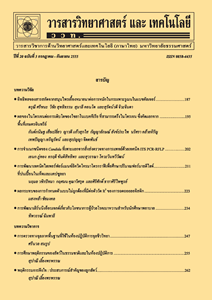Effect of Plant Growth Regulators on Diterpene Lactone Production in Callus Culture of Andrographis paniculata
Main Article Content
Abstract
Andrographis paniculata is a medicinal plant which attributes for diverse pharmacological properties. The main secondary metabolite of A. paniculata is total lactones which comprise of 4 compounds, such as andrographolide, neoandrographolide, 14-deoxy-11,12-didehydroandrogra pholide and 14-deoxyandrographolide. This research aims to induce callus for secondary metabolite production by cell culture technique. The effect of growth regulators, i.e. cytokinins as benzylaminopurine (BAP) and auxins as 2,4-dichlorophenoxyacetic acid (2,4-D), on the induction of callus from explants cultured on Murashige and Skoog (MS) was studied. From the result, MS supplemented with BAP and 2,4-D at concentrations of 1 and 1 mg/L, respectively, can induce callus formation. Then compounds in the callus extract were analyzed by the TLC techniques, and lactones were determined by colorimetric method using UV-Vis spectrophotometer. The result showed that Andrographis paniculata callus contains 7.31±0.15 %w/w total lactones.
Article Details
References
Jarukamjorn, K. and Nemoto, N., 2008, Pharmacological Aspects of Andrographis paniculata on health and its major diterpenoid constituent andrographolide, J. Health Sci 54: 370-381.
Akhtar, M.T., Sarib, M.S.B.M., Ismail, I.S., Abas, F., Ismail, A., Lajis, N.H. and Shaari, K., 2016, Anti-diabetic activity and metabolic changes induced by Andrographis paniculata plant extract in obese diabetic rats, Molecules 21(8): 1026.
Low, M., Khoo, C.S., Münch, G., Govindaraghavan, S. and Sucher, N.J., 2015, An in vitro study of anti-inflammatory activity of standardised Andrographis paniculata extracts and pure andrographolide, BMC Complem. Altern. Med. 15(1): 18.
Menon, V. and Bhat, S., 2010, Anticancer activity of andrographolide semisynthetic derivatives. Nat Prod Commun. 5(5): 717-720.
Hossain, M.S., Urbi, Z., Sule, A. and Hafizur Rahman, K.M., 2014, Andrographis paniculata (Burm. f.) Wall. ex Nees: A review of ethnobotany, phytochemistry, and pharmacology, Sci. World J. 2014: 274905-274905.
Santos-Neto, L.L.D., de Vilhena Toledo, M.A., Souza, P.M. and de Souza, G.A., 2006, The use of herbal medicine in Alzheimer's disease – a systematic review, Evidence-based Complem. Altern. Med. 3: 441-445.
Dias, M.I., Sousa, M.J., Alves, R.C. and Ferreira, I.C.F.R., 2016, Exploring plant tissue culture to improve the production of phenolic compounds: A review, Ind. Crops Prod. 82: 9-22.
Saw, N.M.M.T., Riedel, H., Cai, Z., Kütük, O. and Smetanska, I., 2012, Stimulation of anthocyanin synthesis in grape (Vitis vinifera) cell cultures by pulsed electric fields and ethephon. Plant Cell, Tiss. Organ Cult. 108: 47-54.
Marwani, D.P.E., Wardhani, K. and Esyanti, R., 2015, Development of hairy root culture of Andrographis paniculata for in vitro adrographollide production, J. Med. Bioeng. 4: 446-450.
Loc, N.H. and Nhat, N.T.D., 2013, Production of asiaticoside from centella (Centella asiatica L. Urban) cells in bioreactor, Asian Pacific J. Trop. Biomed. 3: 806-810.
Kaewpiboon, C., 2004, Effect of Plant Growth Regulators to the Differentiation and Development of Grape Callus, Bachelor’s Special Project in Applied Biology, King Mongkut's institute of Technology Ladkrabang, Bangkok. (in Thai)
Sharmila, R., Subburathinam, K.M. and Sugumar, P., 2013, Effect of growth regulators on andrographolide production in callus cultures of Andrographis paniculata, Adv. Biotech. 12(9): 17-19.
Sombut, S., Bunthawong, R., Sirion, U., Kasemsuk, T., Piyachaturawat, P., Suksen, K., Suksamrarn, A. and Saeeng, R., 2017, Synthesis of 14-deoxy-11,12-didehydro andrographolide analogues as potential cytotoxic agents for cholangiocarcinoma, Bioorg. Med. Chem. Lett. 27: 5139-5143.
Sharma, S.N. and Jha, Z., 2012, Production of andrographolide from callus and cell suspension culture of Andrographis paniculata, J. Cell Tiss. Res. 12: 3423-3429.
Jindal, N., Kajla, S. and Chaudhury, A., 2016, Establishment of callus cultures of Andrographis paniculata for the assesment of andrographolide content, Int. J. Res. Ayurveda Pharm. 7: 197-201.
Praveen, N., Manohar, S.H., Naik, P.M., Nayeem, A., Jeong, J.H. and Murthy, H.N., 2009, Production of andrographolide from adventitious root cultures of Androgra phis paniculata, Curr. Sci. 96: 694-697.
Vakil, M. and Mendhulkar, V., 2013, Salicylic acid and chitosan mediated abiotic stress in cell suspension culture of Andrographis paniculata (Burm.F.) Nees. for andrographolide synthesis, Int. Pharm. Sci. Res. 4: 3453-3459.


